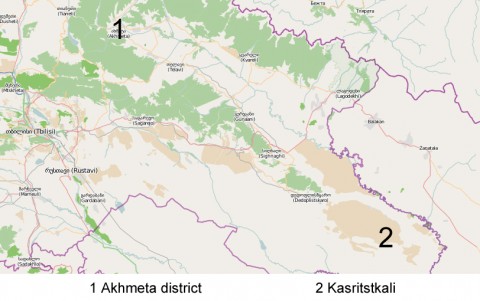This weekend we visited one of the more remote parts of Georgia, the Shiraki plains at the border to Azerbaijan. After passing through Dedoplis Tskaro, the district capital and largest town in this part of Georgia, we found ourselves on a bad road going all the way to the small town of Kasritstkali. In Soviet times the road was surfaced, but these days one has to navigate mud and large potholes. By all accounts the small town of Kasritstkali is thoroughly isolated from the rest of Georgia. And for what it matters, from Azerbaijan as well. Although the border is only a few kilometres away there is no road, let alone an official border crossing.
This is exactly what economic theory would suggest. New roads and other transportation infrastructure create benefits. If the road is build in the middle of the country all benefits will accrue to the country. If a new road is connecting to a neighbouring country, some of the benefits of the road will accrue to the neighboring country. Unless transportation planners care about the welfare of the neighbouring country, a less than optimal number of roads will be build in border regions.
In fact, there is a little twist to the story of this small town in the middle of nowhere. Although I cannot 100% confirm it, it appears that the area around Kasritstkali is administered by the Dedoplis Tskaro district, but Kasritstkali itself is administered by the Akhmeta district. But the Akhmeta district is far away, and is not even bordering the Dedoplis Tskaro district. Essentially Kasritstkali is a small enclave. It’s unclear why, but I have the following theory: Most people living in Kasritstkali are from the Akhmeta district. In the summer they travel with their flock of sheep to the mountains; and in the winter they live on the Shiraki plains around Kasritstkali. Whether or not this is reason for this strange arrangement, being part of a district far away certainly does not help Kasritstkali getting a better road to Dedoplis Tskaro and the outside world.
The bigger question of course is what Armenia, Azerbaijan and Georgia and other regional players can do to improve cross-border infrastructure in the South Caucasus. Interestingly we can observe two different approaches. On one side Georgia is cooperating with Armenia and Azerbaijan in the construction of new cross-border infrastructure such as the Baku-Tbilisi-Kars railway line or the proposed road connecting Armenia with Adjara. On the other side Georgia unilaterally reduced import tariffs and simplified its customs procedures, benefiting not only Georgia but also neighbouring countries. In light of the positive externalities it created for its neighbors the latter seems to be a rather remarkable reform.
For some of our photos of this area, please see here.
















Comments
A lot could be done to promote true market integration in the South Caucasus (ignoring for the moment other aspects of regional collaboration), but so far the regional borders have been open only in one direction (to Georgia) or not open at all.
The main roads connecting Georgia with Armenia and Azerbaijan are actually improving, but there are still other barriers to trade (export) that in many cases prove to be insurmountable.
In fact, when there are no artificial barriers to trade, even bad road infrastructure is not a huge problem. When traveling on the Georgian Military Highway last summer I was surprised by the number of trailers making their way from Russian to Armenia (?) through Georgia on a mountainous road that was difficult even for an SUV...
The main international roads connecting Georgia to Armenia and Azerbaijan are actually improving in recent years, but this is not a sufficient condition for the South Caucasus to be economically integrated. While Georgia has fully liberalized its trade and modernized border crossings, Armenia and Azerbaijan are protecting their markets by inefficient borders and non-tariff barriers, which in some cases appear to perform as well as the Great Chinese Wall...
In fact, good roads are not even a necessary condition for trade to flourish. When there are no artificial barriers to trade and arbitrage possibilities are significant, even bad road infrastructure is not a huge problem. When traveling on the Georgian Military Highway last summer I was surprised by the number of huge trailers making their way from Russia. Most of these were probably transiting through Georgia to Armenia. Some stretches of this road, especially near the mountain pass, were difficult even for an SUV. The trucks had to slow down to a snail's pace but nothing could stop them from advancing...
To follow up, there is this article http://www.humanrights.ge/index.php?a=main&pid=10402&lang=eng, quote: "Kasristskali is located at Georgia-Azerbaijan border near the village of Kvemo Kedebi in Dedoplistskaro district. However, officially it is within Akhmeta District. In spring and winter villagers cannot travel to the district center because of severely damaged road."
A very nice observation! However, it also shows how trivial some results of economic theory are. I do not need a formal model in order to see that spillover effects will reduce investments in public goods in border regions. Yet exactly this insight seems to be the result of the formal model by to which you provided a link. This is another issue, but I think that we economists should be a bit more self-critical. I will probably come up with my own blog entry about this issue...